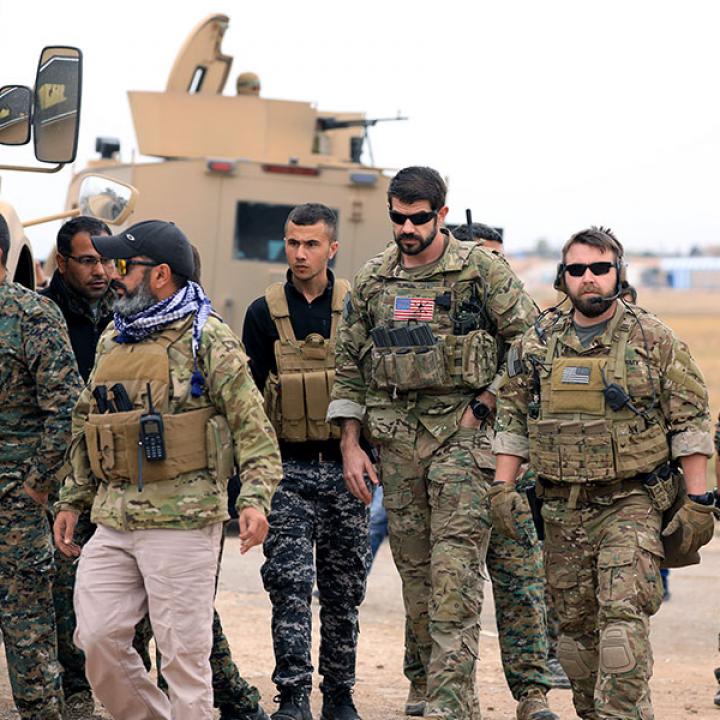

If Washington abandons its low-cost, high-impact approach to fighting ISIS in Syria, it will pave the way for a host of bad actors to reestablish themselves there.
President Donald Trump’s December 19 decision to withdraw U.S. troops and airpower from Syria has thrown a handful of U.S. policies and scores of U.S. partnerships into chaos. The war against the Islamic State and the maximum pressure campaign on Iran now face grave uncertainty, and both the Islamic State and Iranian security hardliners and proxies will move quickly to exploit new opportunities.
Yet there is also an opportunity for America and its allies and partners to get creative, and to do so in a way that might satisfy President Trump—the ultimate disrupter—that he has secured a better deal in the process. As a detailed Associated Press account of his phone briefing with Turkish President Recep Tayyip Erdogan vividly paints, a myopic focus on the territorial degradation of the Islamic State caliphate led the U.S. president to conclude that the war against the group has been won. U.S. officials were trapped by their own claims that ISIS held only one percent of the territory it once occupied in Syria.
In fact, terrain has never been the key metric. Numbers of enemy fighters and numbers of ongoing attacks demonstrate that the Islamic State has not been defeated in either Syria or Iraq.
In Syria, the main body of Islamic State fighters has been encircled in a small area called Hajjin, but there are still more than 2,000 hardened terrorists in the pocket. (There are thousands more Islamic State fighters in Idlib, in western Syria, where the group has presently gone to ground).
If, as expected, Assad regime and pro-Iranian forces move across the Euphrates to Hajjin, the Islamic State will exploit the chaos to spread out again as the U.S.-led coalition loosens the noose. When eastern Syria and parts of Iraq destabilize again, President Trump will be quickly and directly shown to have misunderstood the situation and repeated President Obama’s mistake in withdrawing from Iraq in 2011 or President George W. Bush’s mistake of declaring “Mission Accomplished” in 2003.
In Iraq, as my new West Point Combating Terrorism Center report shows, the Islamic State is fully active, launching 1,271 attacks in the first 10 months of 2018 (including 762 bombings). In January to October 2018, the Islamic State undertook 135 attempted mass-casualty attacks and 270 effective roadside bombings. They also mounted overrun attacks on 120 Iraqi security force checkpoints or outposts, and executed 148 precise killings of specifically targeted individuals such as village mukhtars, tribal heads, district council members, or security force leaders.
Between 2011 and 2014, the Syrian civil war gave the Islamic State in Iraq an expanding sanctuary and access to military equipment, high explosives, manpower, and finances. We can expect Iraq to destabilize again if these conditions return.
This is a legacy-defining moment for the Trump presidency. In the same way President Obama called the Islamic State the “JV team” right before they burst out, conquering a third of Iraq, this president risks being forever remembered as the man who let the Islamic State off the hook as their strength was failing, snatching defeat from the jaws of victory. December 2018 may also be remembered as the moment when the counter-Iran strategy collapsed, paving the way for Iran’s expansion across the region, accelerating the move towards a destructive war involving Israel, and emboldening an Iranian dash for nuclear weapons ownership.
A full U.S. default in Syria will also have global consequences for allies and adversaries. Just as Obama’s abandoned chemical weapons red line in 2013 led to greater assertiveness by Russia, China, and North Korea in the years afterwards, so is this decision likely to further embolden our adversaries, and encourage our friends and partners to take erratic steps such as pursuing nuclear weapons, launching preemptive military operations, or cutting deals with Iran.
But there are still ways to reframe our counter-terrorism effort in Syria. Withdrawing too quickly and completely is the disastrous Obama model: fighting smarter and lighter with more burden-sharing should be the Trump model.
The U.S. mission in Syria is low-cost and high-impact. With a very small number of U.S. forces in Syria, President Trump has smashed ISIS control of territory, moving the U.S. a long way towards the enduring defeat of ISIS. This was a fantastic bargain compared to the large missions of the past. It is not correct to characterize Syria as high-cost, low-impact, because the reverse is true.
The President has stated this week that U.S. counter terrorism in Syria will continue and that the U.S. can re-engage as needed. This flexibility should now be tested, but not in a way that directly pushes President Trump into a corner over making his decision, which is his right as the U.S. commander-in-chief.
All measures should be explored immediately to raise non-U.S. contributions (European, Turkish, and Iraqi Kurdish) to the Syrian Democratic Forces counterterrorism campaign, and to reduce permanent U.S. presence, to make the operation even more cost-effective for America. This must be done quickly, because Iran and Russia and Assad will move rapidly to enter eastern Syria, but not to eliminate the Islamic State—more likely to seize oilfields and push ISIS into Iraq or Turkey or other parts of the region where they will continue to pose a threat.
Michael Knights is a senior fellow with The Washington Institute. This article was originally published on The Brief website.
The Brief

